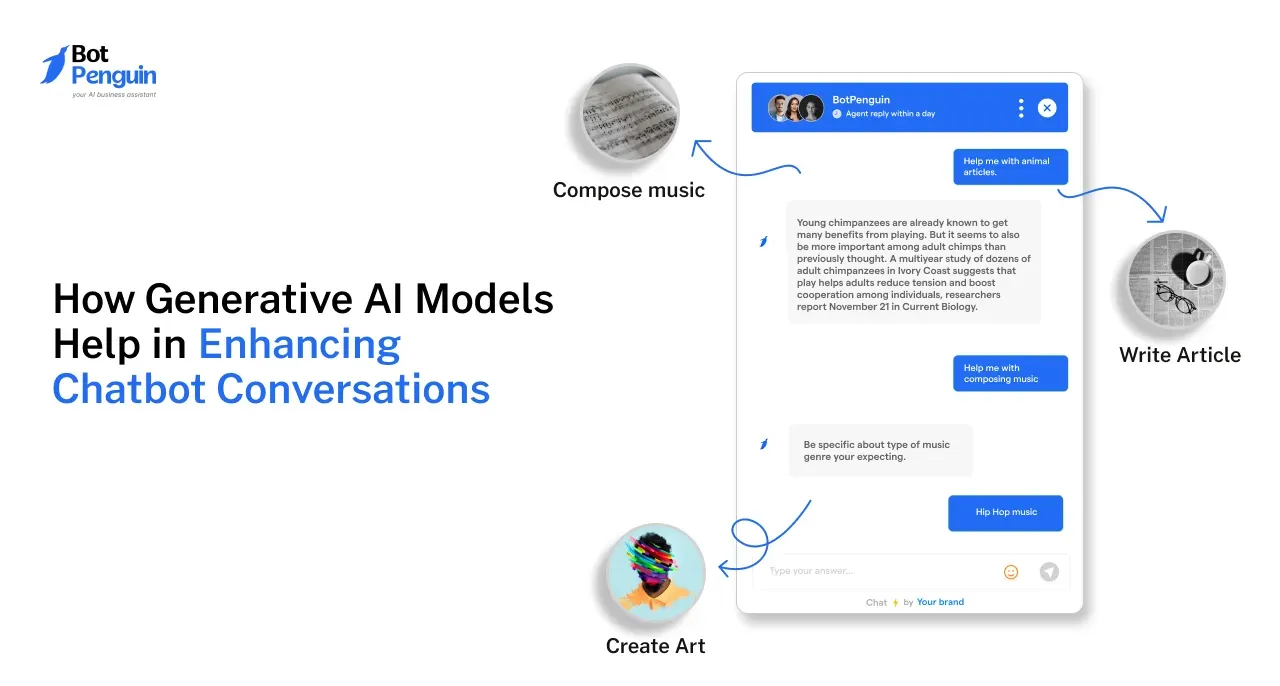AI agentic workflows have emerged as a game-changing concept for businesses. But what is agentic workflows, and why is it gaining such traction?
AI agentic workflows in AI refer to autonomous, goal-oriented processes that can adapt and make decisions without constant human intervention.
Recent statistics highlight the growing importance of AI agentic workflows. According to Gartner, by 2025, 70% of organizations will have operationalized AI architectures, up from 5% in 2023, with AI agentic workflows playing a crucial role (Gartner, 2024).
Furthermore, businesses implementing AI agentic workflows solutions have reported a 35% increase in operational efficiency (McKinsey, 2024).
The concept of agentic LLM (Large Language Models) is at the heart of these advancements. These models, capable of understanding context and generating human-like responses, are driving the evolution of AI agentic workflows.
A study by MIT Technology Review (2024) found that companies leveraging agentic LLMs in their workflows saw a 40% reduction in task completion time.
This guide will explore the intricacies of AI agentic workflows, their applications, and how businesses can harness its power to stay competitive in an AI-driven world.
Understanding AI Agentic Workflows
AI agentic workflows are automated processes powered by intelligent agents—software that can learn, adapt, and make decisions.

Unlike traditional automation, which follows predefined rules, an AI agentic workflow uses machine learning models, like agentic LLMs (Large Language Models), to understand and respond to dynamic situations.
AI Agentic workflow can perform tasks independently, allowing businesses to operate more efficiently and with less human oversight.
Difference Between Traditional Workflows and AI-Driven Workflows
Traditional workflows rely heavily on manual processes or static rules programmed into software. In contrast, AI agentic workflows adapt and evolve based on new data and changing circumstances.
This difference allows AI-driven workflows to handle more complex scenarios, predict outcomes, and optimize processes in real-time.
For example, a traditional workflow might require constant updates to maintain relevance, while an AI Agentic workflows can learn from past experiences and adjust its actions accordingly.
Examples of Common Tasks AI Agents can Handle in Business
AI agent workflow excels in handling a wide range of business tasks. Common examples include customer support automation, where chatbots driven by agentic LLMs provide instant responses to customer inquiries.
In marketing, AI Agentic workflows can analyze vast amounts of data to personalize content and target the right audience segments. Additionally, they streamline supply chain management by predicting demand and optimizing inventory levels.
Types of AI Agent Workflow

Understanding the different types of AI agent workflow is key to leveraging AI agentic workflows in a business.
These agents have unique capabilities and functions, allowing them to handle specific tasks and adapt to different scenarios. Let's break down the types of AI agent workflow that form the foundation of AI agentic workflows.
Simple Reflex Agent
A simple reflex AI agent workflow operates solely based on current observations. It follows predefined rules and reacts to specific inputs without considering past experiences or future consequences.
This type of agent is suitable for straightforward tasks where the environment is predictable, but it lacks adaptability, making it less effective for complex AI agentic workflows.
Model-Based Reflex Agent

A model-based reflex AI agent workflow goes a step further by maintaining an internal model of the world.
This model helps the agent understand how its actions impact the environment, allowing it to make decisions based on both current observations and historical data.
It is more versatile than the simple reflex agent and can be integrated into more dynamic AI agentic workflows.
Goal-Based Agent
A goal-based AI agent workflow focuses on achieving specific objectives. It chooses actions by considering the future and evaluates how these actions will lead to achieving a desired goal.
This agent is particularly useful in AI agentic workflows where decision-making and problem-solving are required, such as optimizing logistics or managing resources.
Utility-Based Agent
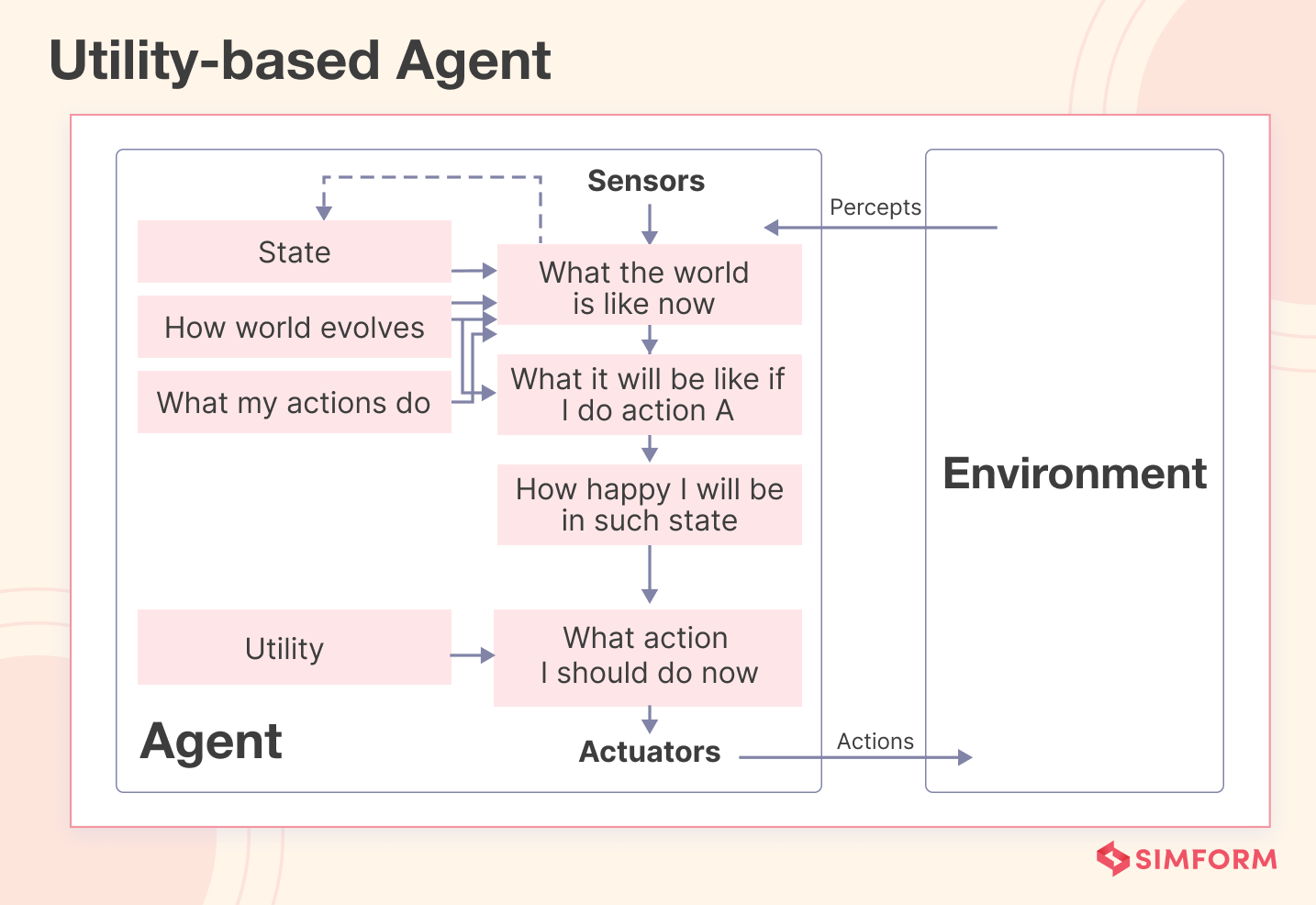
A utility-based AI agent workflow is designed to maximize overall satisfaction or "utility." It evaluates various outcomes based on predefined utility measures, choosing the action that provides the best result.
These agents are ideal for complex AI agentic workflows where multiple factors need to be balanced, like in customer service scenarios where response time, accuracy, and customer satisfaction all play a role.
Learning Agent
A learning AI agent workflow is capable of improving its performance over time. It learns from past experiences and feedback, adapting to new conditions without human intervention.
This type of agent is crucial for AI agentic workflows in AI where environments are constantly changing.
For instance, in marketing, a learning agent can refine its strategies by analyzing customer data trends and behaviors, making it a core component of advanced AI agentic workflows.
Benefits of AI Agentic Workflows for Businesses
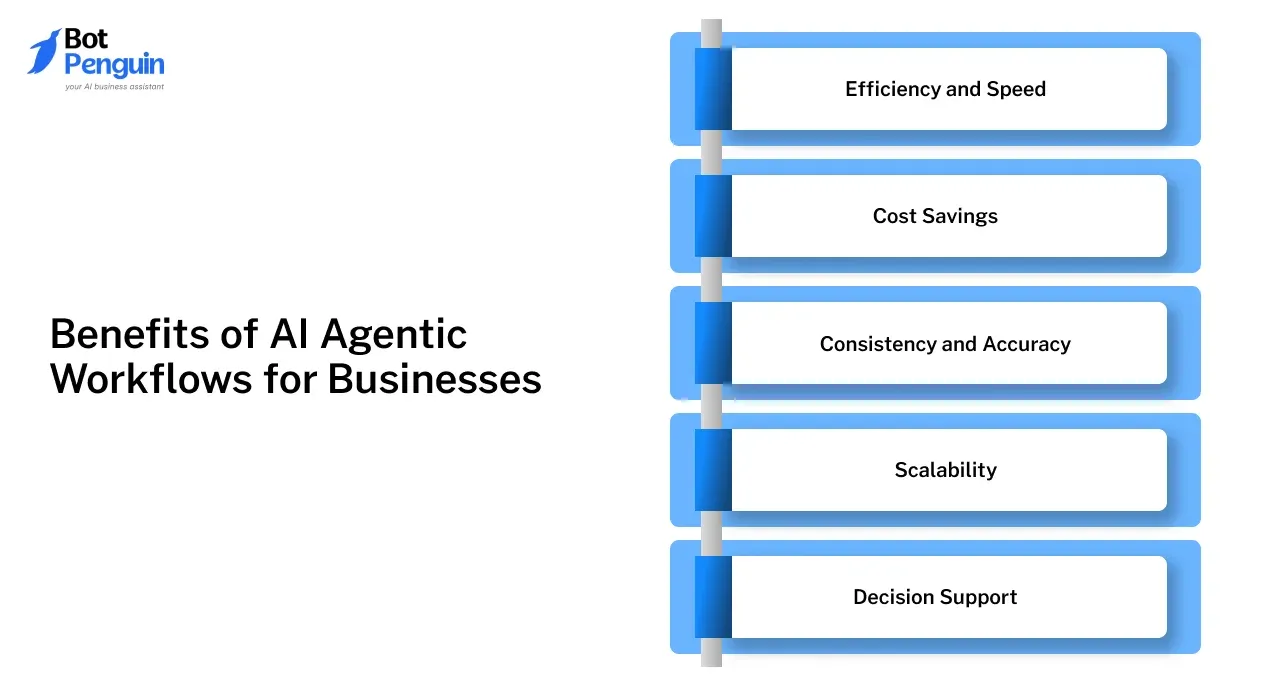
Implementing AI agentic workflows can transform how businesses operate, bringing a range of benefits from cost savings to enhanced decision-making.
These workflows use intelligent agents to automate processes, adapt to changes, and provide valuable insights. Let's look at the specific advantages of adopting AI agentic workflows in a business context.
Efficiency and Speed
AI agents handle tasks much faster than humans, significantly improving efficiency.
With AI agentic workflows, routine operations like data entry or customer queries can be automated, freeing up human resources for more strategic work. This speed boosts productivity across the board.
Cost Savings
One of the most significant advantages of AI agentic workflows is cost reduction.
By automating tasks, businesses reduce their reliance on human labor, cutting down on wages and related operational expenses. This cost-efficiency is a compelling reason for businesses to adopt AI agentic workflows strategies.
Consistency and Accuracy
AI agents excel at repetitive tasks without making errors, ensuring high levels of accuracy and consistency.
Unlike humans, they don’t suffer from fatigue, reducing the risk of mistakes in tasks like data processing or order fulfillment. This reliability makes AI agentic workflows indispensable for maintaining quality standards.
Scalability
AI agentic workflows are highly scalable, allowing businesses to manage increased workloads without needing additional resources.
Whether it’s handling more customer inquiries or processing larger datasets, AI-driven workflows expand capacity effortlessly, supporting business growth without proportional increases in costs.
Decision Support
AI agents provide valuable, data-driven insights that aid in decision-making.
Through the use of agentic LLMs, businesses can analyze large amounts of data, identify patterns, and predict trends, enhancing strategic planning and operational decisions.
This capability makes AI Agentic workflows essential for staying competitive in today's fast-paced market.
Key Components of an AI Agentic Workflows
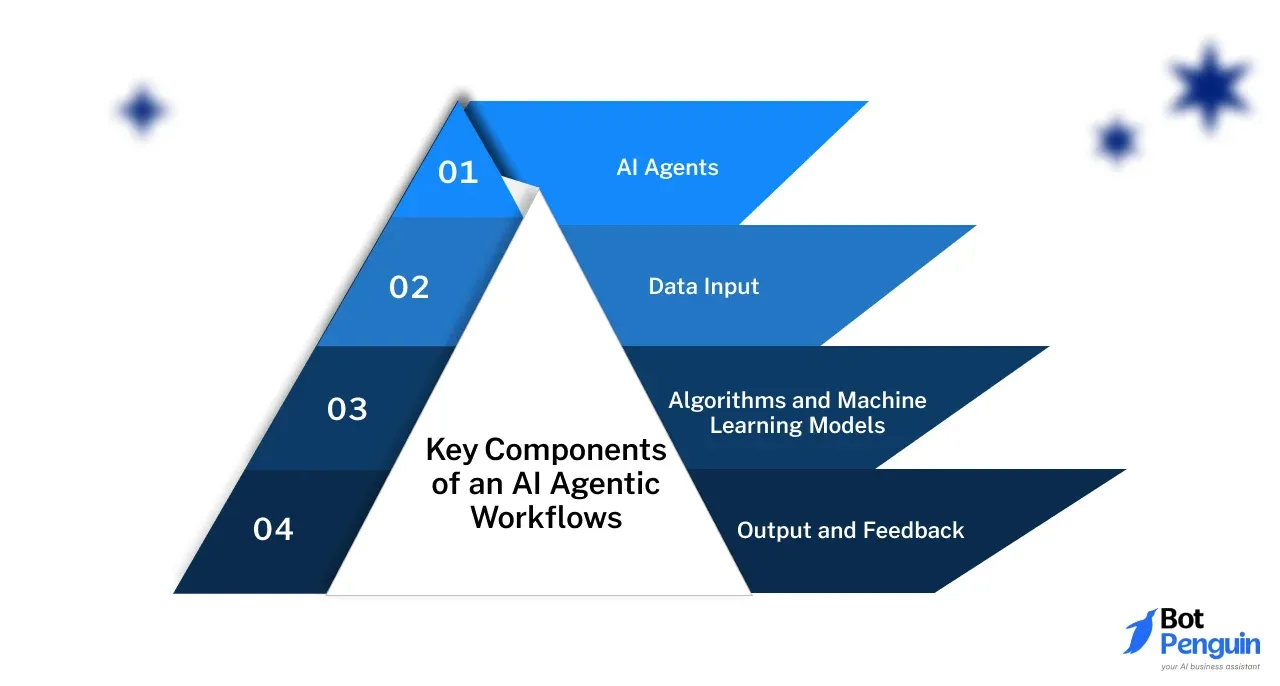
For businesses looking to implement AI agentic workflows, understanding the key components is essential. These workflows are built on a combination of AI agents, data inputs, algorithms, and feedback mechanisms.
Let’s explore these elements that make up an effective AI Agentic workflows.
AI Agents
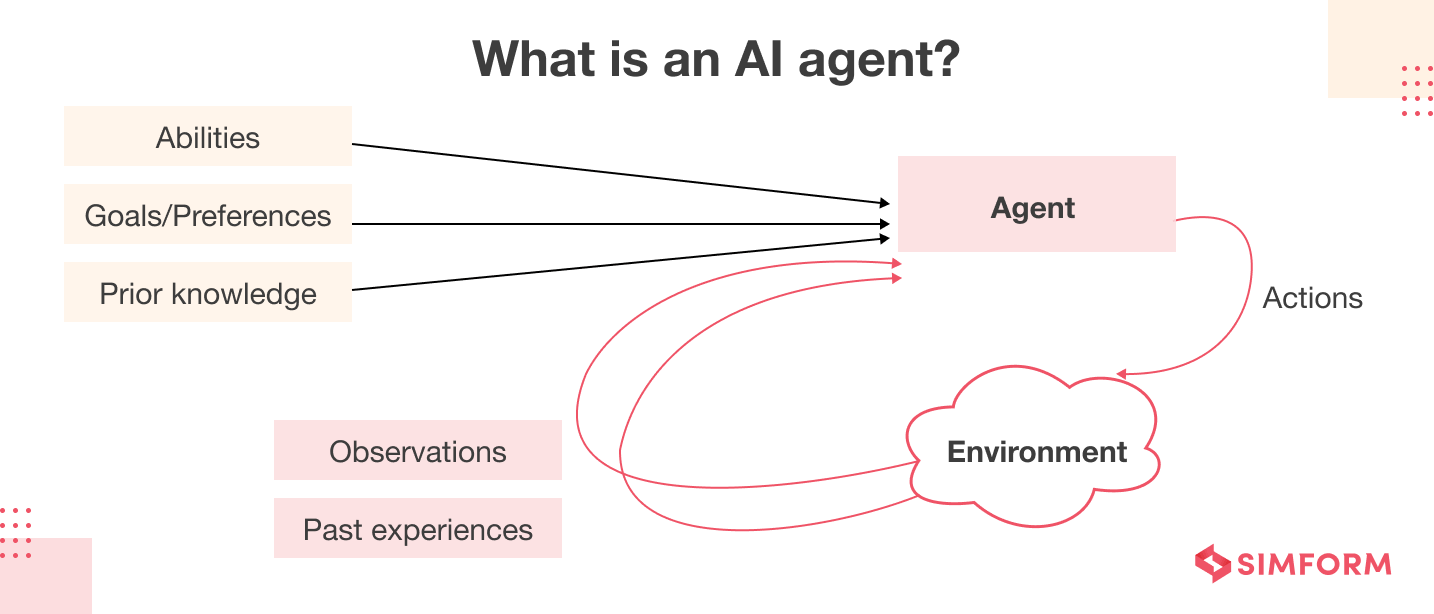
At the core of AI agentic workflows are AI agents. AI Agentic workflows can range from simple chatbots that handle customer queries to advanced automation software that manages supply chains.
Each type of agent serves a specific function, such as interacting with users, processing information, or making decisions based on data. The choice of AI agent depends on the business's needs and the complexity of the tasks involved.
Data Input
Data is the fuel for AI Agentic workflows. AI agents work with both structured data (like databases and spreadsheets) and unstructured data (like emails and social media posts).
The workflow begins with feeding this data into the AI system, where it is analyzed and interpreted. The effectiveness of an AI agentic workflows relies heavily on the quality and relevance of the input data.
Algorithms and Machine Learning Models

Algorithms and machine learning models are the brains behind the AI agentic workflows. They process the input data, recognize patterns, and learn from it.
Models like agentic LLMs (Large Language Models) allow agents to understand language, generate insights, and predict outcomes. This continuous learning enables the agents to improve over time and handle more complex tasks.
Output and Feedback
The final component of an AI Agentic workflows is delivering results and learning from feedback. AI agents generate outputs, such as answers to customer inquiries or suggestions for inventory management.
They also gather feedback from user interactions, refining their processes and decision-making abilities. This feedback loop is critical for maintaining the accuracy and effectiveness of the workflow.
Common Use Cases of AI Agentic Workflows in Business
AI agentic workflows have a wide range of applications across different business functions.
From enhancing customer service to optimizing supply chain management, these workflows provide businesses with the tools to automate tasks, improve decision-making, and increase efficiency.
Let's explore some of the most common use cases for AI agentic workflows.
Customer Service
AI chatbots are a prime example of AI Agentic workflows in customer service. These intelligent agents are available 24/7, providing instant responses to customer queries.
By handling routine questions and issues, AI chatbots reduce the workload on human agents and improve response times. This leads to better customer experiences and frees up resources for more complex tasks.
Marketing and Sales Automation
AI Agentic workflows plays a crucial role in marketing and sales by enabling personalization and targeted campaigns.
AI-driven workflows analyze customer data to deliver tailored messages, offers, and content to the right audience at the right time. This enhances engagement and boosts conversion rates.
The AI agentic workflows can also automate repetitive tasks like lead scoring, freeing up sales teams to focus on closing deals.
Human Resources
AI can streamline HR processes through AI Agentic workflows that automate recruitment, onboarding, and performance tracking.
For example, AI agentic workflows tools can scan resumes and rank candidates, schedule interviews, and provide onboarding materials.
Additionally, agentic LLMs help in managing employee records and tracking performance metrics, allowing HR teams to make data-driven decisions.
Supply Chain Management
AI Agentic workflows is transforming supply chain management by optimizing inventory tracking and demand forecasting.
AI agents monitor stock levels in real time, predict future demand, and automatically reorder supplies as needed. These workflows reduce inventory costs, prevent stockouts, and improve supply chain efficiency with the help of AI agentic workflows.
Financial Operations
AI is making financial operations smarter and more secure. AI agentic workflows help detect fraud by analyzing transaction patterns and identifying anomalies.
They also assist in financial reporting by automating data collection and analysis, reducing the time required for closing accounts. Expense management is another area where AI agents help businesses control costs and maintain compliance.
How to Implement AI Agentic Workflows
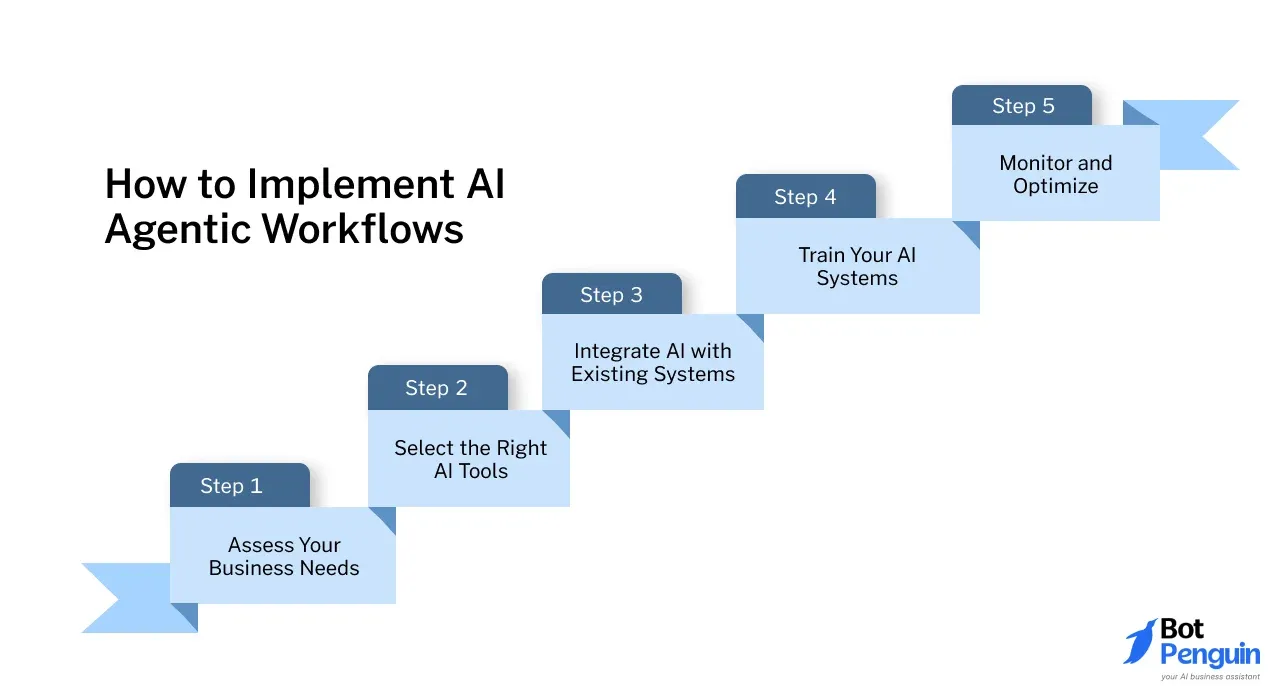
Implementing AI agentic workflows can significantly boost a business's efficiency, reduce costs, and improve decision-making.
However, a structured approach is essential to maximize these benefits. Here are the steps to successfully implement AI Agentic workflows in your business.
Step 1
Assess Your Business Needs
Start by identifying the areas where AI can add the most value. Look for repetitive tasks, decision-heavy processes, or data-rich activities where automation and AI could improve efficiency.
Understanding your business needs will help determine the AI Agentic workflow and where it fits within your organization.
Step 2
Select the Right AI Tools
Choose the AI platforms and tools that match your workflow needs. This includes selecting the right type of AI agents, whether they are chatbots, recommendation engines, or data analysis tools.
Consider factors like integration capabilities, ease of use, and scalability. The right choice will set the foundation for effective AI Agentic workflows.
Step 3
Integrate AI with Existing Systems
To achieve seamless AI agentic workflows, integrate the chosen AI tools with your current business systems.
Ensure that the AI agents can access the necessary data and work smoothly with existing software platforms. This step is crucial for creating a unified AI Agentic workflows that enhances, rather than disrupts, your existing operations.
Step 4
Train Your AI Systems
AI agents must be properly trained to function effectively. Use historical data to teach the AI how to perform its designated tasks.
Training should be thorough to ensure the AI learns patterns, understands nuances, and can make accurate decisions. Proper training is essential for achieving reliable results from your AI Agentic workflows.
Step 5
Monitor and Optimize
Finally, continuously monitor the performance of your AI systems. Use feedback to identify areas for improvement.
Regular analysis helps refine algorithms, update data inputs, and optimize AI Agentic workflows. This ensures the AI remains aligned with your business goals and adapts to changing conditions over time.
Challenges and Limitations of AI Agentic Workflows
While AI agentic workflows offer many advantages, there are also challenges and limitations businesses need to consider. Addressing these challenges is crucial for maximizing the benefits of AI-driven processes.
Here are some common hurdles businesses face when implementing AI agentic workflows.
Data Privacy Concerns
Handling sensitive business and customer data is a significant concern in AI agentic workflows.
AI systems often require access to large amounts of data, raising questions about data security and privacy. Businesses need to implement strict data governance policies and comply with regulations to protect sensitive information.
Implementation Costs
Setting up AI agentic workflows requires a considerable upfront investment. Costs may include purchasing AI tools, integrating them with existing systems, and training staff.
While these costs can be offset by long-term gains in efficiency, they remain a barrier for many businesses initially.
Human Oversight
Despite their capabilities, AI agents still require human supervision, especially in critical tasks. AI agentic workflows cannot replace human judgment and decision-making entirely.
Human oversight is essential to handle exceptions, provide context, and ensure ethical use of AI.
Adapting to Change
Transitioning from traditional to AI-driven workflows can be challenging. Employees may resist change or find it difficult to adapt to new processes.
It requires time and training to adjust to AI agentic workflows and understand how it fits into the existing operations.
Conclusion
In conclusion, AI agentic workflows are revolutionizing business operations across industries. The adoption of AI agentic workflows is no longer a luxury but a necessity for staying competitive.
As we've explored, AI agentic workflows empower businesses to automate complex processes, enhance decision-making, and drive innovation.
The integration of agentic LLM technology within AI agentic workflows systems further amplifies their capabilities, enabling more sophisticated and context-aware operations.
Understanding AI agentic workflows and how to implement it effectively is crucial for modern businesses. By leveraging AI agentic workflows solutions, companies can significantly improve efficiency, reduce errors, and free up human resources for more strategic tasks.
The future of business operations lies in the seamless integration of human expertise and AI-driven agentic workflows.
As AI continues to evolve, so too will the potential of AI agentic workflows. Businesses that embrace and master AI agentic workflows now will be well-positioned to lead in their respective industries, harnessing the full power of artificial intelligence to drive growth and innovation.
Frequently Asked Questions (FAQs)
What is an AI agentic workflow?
An AI agentic workflow uses AI agents to automate tasks, make decisions, and manage workflows.
It involves AI systems handling repetitive processes, optimizing operations, and improving efficiency within a business environment.
How can AI agentic workflows benefit businesses?
AI agentic workflows enhance efficiency, reduce costs, improve accuracy, and scale operations.
They provide data-driven insights, streamline tasks, and help businesses make informed decisions, ultimately driving growth and competitive advantage.
What are some common use cases of AI agentic workflow in businesses?
Common use cases include customer service automation, targeted marketing, HR management, supply chain optimization, and financial operations like fraud detection, expense management, and reporting.
How do you implement an AI agentic workflows in a business?
To implement AI agentic workflow, assess business needs, select appropriate AI tools, integrate with existing systems, train AI models using historical data, and continuously monitor and optimize the workflow for improvements.
What challenges do businesses face with AI agentic workflows?
Challenges include data privacy concerns, high implementation costs, the need for human oversight, and resistance to change.
Addressing these challenges is crucial for successful adoption and maximizing the benefits of AI.
Are AI agentic workflows suitable for all types of businesses?
AI agentic workflow are suitable for many businesses but may not be ideal for those with limited data or where human judgment is essential. Each business should evaluate its specific needs and resources before implementing AI workflows.



